Client has provided sample flies of their data from the following data sources:
Google Campaign Manager

Below are the requirements from the client and additional information:
• The sources are linked to each other by shared Media Buy names.
• In addition-to the mutual Media Buys, the sources contain campaign and site values. However, the client would like to see the campaign/site values coming from Google CM and not from Google DV360.
• The source of truth for cost is Google DV360.
As a first step, a Parent-Child relationship was created between the two files, and the following mapping was performed, within both data streams:
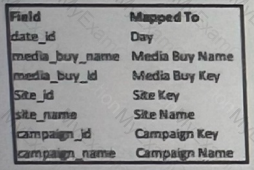
Please note:
• All other measurements were mapped as well to the appropriate fields.
• No other mapping manipulations or formulas were implemented.
How many records will the merged table hold?
The following file was uploaded into Marketing Cloud Intelligence as a Generic Data Stream type:

The mapping is as follows:
Day — Day
web_site_key —> Main Generic Entity Key
web_site_name —> Main Generic Entity Name
Web_site_source —> Main Generic Entity Attribute 01
Page Views — Generic Metric 1
How many rows will be stored in Marketing Cloud Intelligence after the above file is ingested?
A technical architect is provided with the logic and Opportunity file shown below:
The opportunity status logic is as follows:
For the opportunity stages “Interestâ€, “Confirmed Interest†and “Registeredâ€, the status should be “Openâ€.
For the opportunity stage “Closedâ€, the opportunity status should be closed.
Otherwise, return null for the opportunity status.
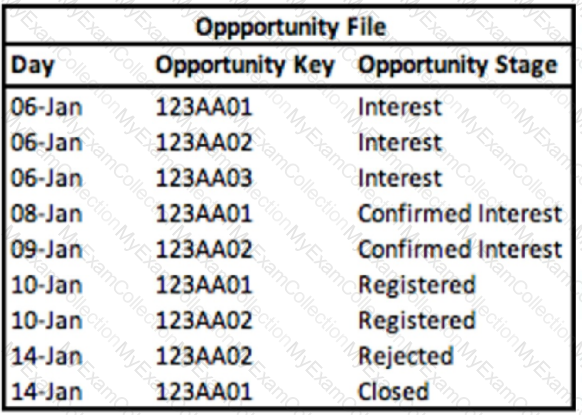
Given the above file and logic and assuming that the file is mapped in a GENERIC data stream type with the following mapping:
“Day†— Standard “Day†field
“Opportunity Key†> Main Generic Entity Key
“Opportunity Stage†— Generic Entity Key 2
“Opportunity Count†— Generic Custom Metric
A pivot table was created to present the count of opportunities in each stage. The pivot table is filtered on Jan 7th - 10th. How many different stages are presented in the table?
A client has integrated data from Facebook Ads, Twitter Ads, and Google Ads in Marketing Cloud Intelligence. For each data source, the data
follows a naming convention as shown below:
Facebook Ads Naming Convention - Campaign Name:
Camp|D_CampName#Market_Objective#TargetAge_TargetGender
Twitter Ads Naming Convention - Media Buy Name:
Market|TargetAge|Objective|OrderID
' Google Ads Naming Convention - Media Buy Name:
Buying Type_Market_Objective
The client wants to harmonize their data on the common fields between these two platforms (i.e. Market and Objective) using the Harmonization ‘Center.
In addition to the previous details, the client provides the following data sample:
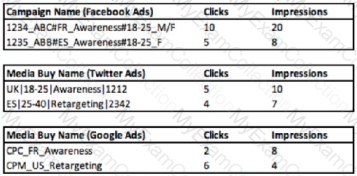
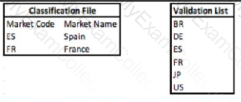
Logic specification:
If a value is not present in the Validation List, return “Not Validâ€
If a value is not present in the Classification File, return “Unclassifiedâ€.
If the Harmonization center is used to harmonize the above data and files, what table will show the final output?
A)

B)

C)

D)

An implementation engineer has been provided with the below dataset:

*Note: CPC = Cost per Click
Formula: Cost / Clicks
Which action should an engineer take to successfully integrate CPC?
Which two statements are correct regarding the Parent-Child configuration?
An implementation engineer is requested to integrate the following files:
File A:

File B:

The client would like to link the two files in order to view the two KPIS (Tasks Completed’ and ‘tasks Assignmed’) alongside’Employee Name’ and/or ‘Squard’.
A Parent-Child configuration was set between the two.
Which two statements are correct?
An implementation engineer has been provided with 4 different source files: 03m 16s
1. Twitter Ads
2. Creative Classification
3. Placement Classification
4, Campaign Category Classification
The main source is Twitter Ads (which includes various fields and KPIs), and the rest are classification files that connect to Twitter Ads and enrich different fields within it.
The connections between the files are described as follows:
1st Party Creative Classification
File structure/headers:

Creative ID — links back to Creative Key (Twitter Ads)
1st Party Placement Classification &
File structure/headers:

Category — links back to Campaign Category (Twitter Ads)
Which proposed solution meets the client's requirements for the above use case?
A)
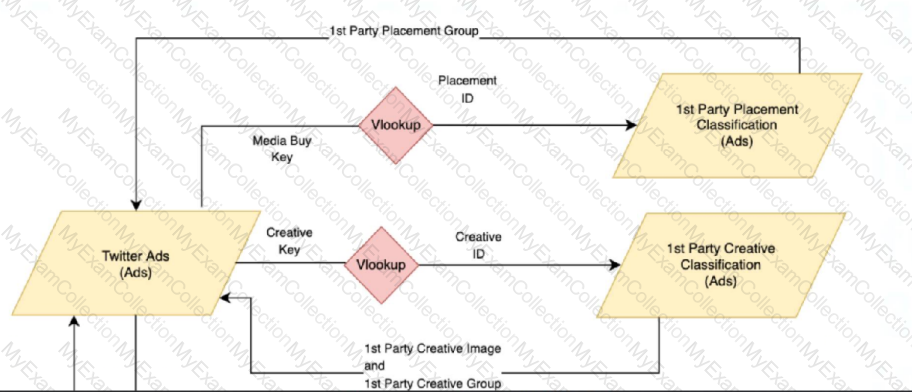
B)
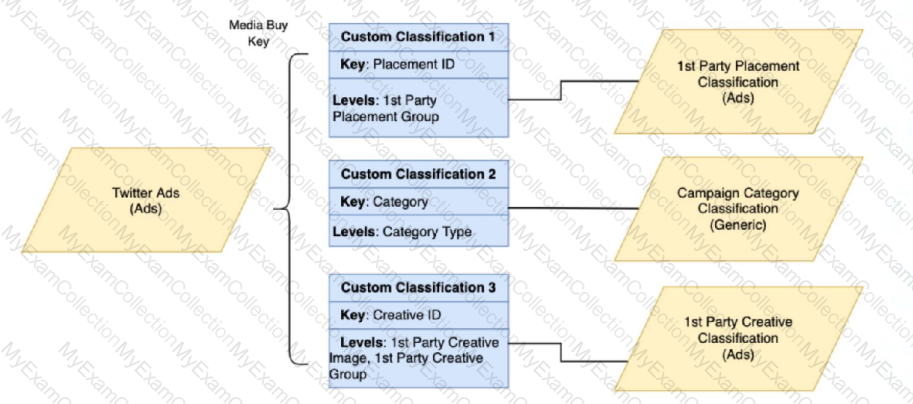
C)
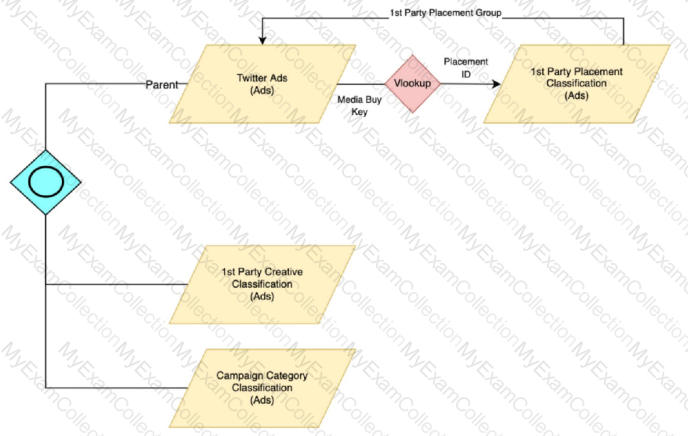
D)
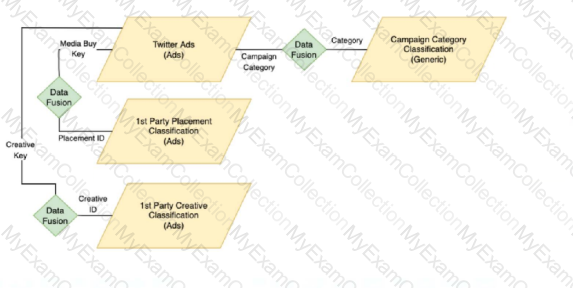
Client has provided sample flies of their data from the following data sources:
Google Campaign Manager

Below are the requirements from the client and additional information:
• The sources are linked to each other by shared Media Buy names.
• In addition-to the mutual Media Buys, the sources contain campaign and site values. However, the client would like to see the campaign/site values coming from Google CM and not from Google DV360.
• The source of truth for cost is Google DV360.
As a first step, a Parent-Child relationship was created between the two files, and the following mapping was performed, within both data streams:

Please note:
• All other measurements were mapped as well to the appropriate fields.
• No other mapping manipulations or formulas were implemented.
How many records will the merged table hold?
A client wants to integrate their data within Marketing Cloud Intelligence to optimize their marketing insights and cross-channel marketing activity analysis. Below are details regarding the different data sources and the number of data streams required for each source.
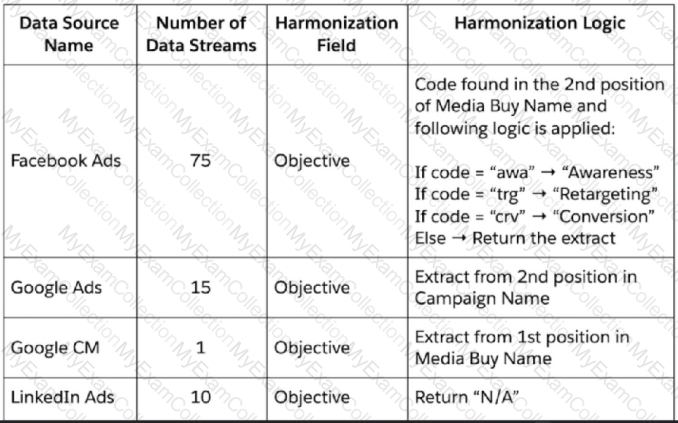
What three advantages are gained when using Patterns & Data Classification as the harmonization method for creating the Objective field?
A technical architect is provided with the logic and Opportunity file shown below:
The opportunity status logic is as follows:
For the opportunity stages “Interestâ€, “Confirmed Interest†and “Registeredâ€, the status should be “Openâ€.
For the opportunity stage “Closedâ€, the opportunity status should be closed Otherwise, return null for the opportunity status.
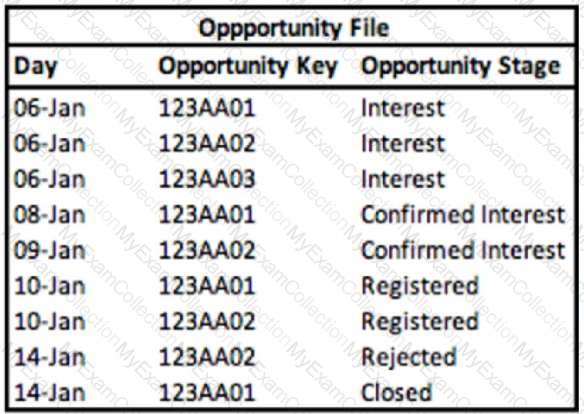
Given the above file and logic and assuming that the file is mapped in a generic data stream type with the following mapping
“Day†— Standard “Day†field
“Opportunity Key†> Main Generic Entity Key
“Opportunity Stage†+ Generic Entity Key 2
A pivot table was created to present the count of opportunities in each stage. The pivot table is filtered on Jan 7th - 11th. Which option reflects the stage(s) the Opportunity key 123AA01 is associated with?
A client provides the following three files:
File A:

File B:

File C:

File A was uploaded using the Ads data stream type.
The client would like to create this view (data from Files B & C) in Datorama:

Which proposed solution would cause a false connection between the two files?
Which two statements are correct regarding variable Dimensions in marketing Cloud intelligence’s data model?
An implementation engineer is requested to apply the following logic:
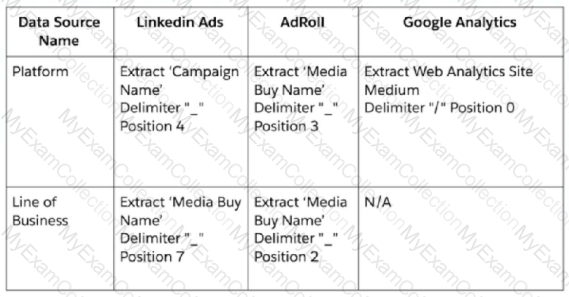
To apply the above logic, the engineer used only the Harmonization Center, without any mapping manipulations. What is the minimum amount of Patterns creating both ‘Platform’ and ‘Line of Business’?"


